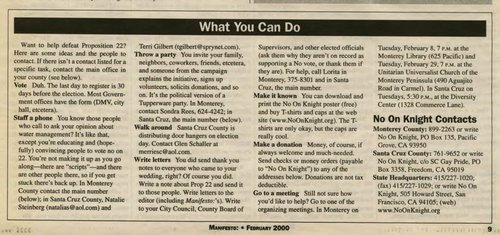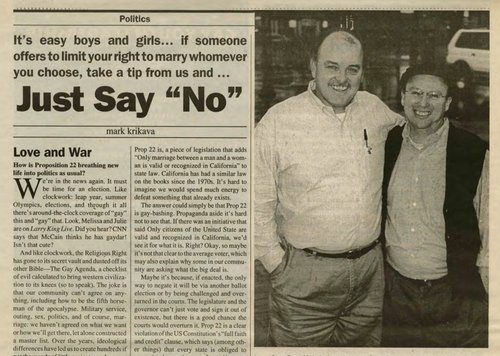Highlights from the Monterey County LGBTQ History Collection
Ballot Measures and Same-Sex Marriage
Between the late 1970’s and the early 2000’s, several propositions, claiming a need to restore traditional values in society, challenged efforts to gain legal marriage rights for same-sex couples. Propositions such as these often brought LGBTQ communities together, sparking activism to confront what many saw as a threat to civil rights. The Monterey County LGBTQ History Collection provides a window on how these wider debates played out locally.
In 1978. Proposition 6, also known as the Briggs Initiative after John Briggs, a Republican state senator who sponsored the measure, sought to ban teachers in any public school in California for “advocating, imposing, encouraging or promoting” homosexuality. [1] Although Proposition 6 was aimed at limiting the visibility of the LGBTQ community, it sparked a public backlash, resulting in its ultimate defeat. The Briggs Initiative laid a foundation for subsequent challenges to rights claimed by the LGBTQ community, including marriage equality.

A good example is Proposition 22, an anti-gay marriage initiative sponsored by state senator Pete Knight for the March 2000 California primary, which defined marriage anywhere in California state law as only “between a man and a woman.” [2] Many LGBTQ folks and their allies in Monterey County found the initiative intrusive, divisive and unfair. LGBTQ communities and Monterey and Santa Cruz counties organized. In February 2000, for example, the Manifesto, an LGBTQ community newspaper archived in the collection, provided a list of “what you can do” to help organize against Proposition 22.

Engaging local media was another strategy. In a draft copy of a letter to the Monterey Herald, activist Matt Friday argued that public discussions of the proposition only highlighted how many on both sides of the issue were “talking about the same thing: love, family, marriage, faith, belonging and responsibility,” suggesting a need to encourage these qualities through a “framework of rights” available to all. [3]
And, most recently, Proposition 8, approved by voters in November 2008, enshrined in the California State Constitution that only a “marriage between a man and a woman is valid or recognized in California.” The proposition was later overturned by several federal courts, including a ruling by the U.S. Supreme Court in 2013, opening a pathway to legal marriage for same-sex couples. [5]
Image sources:
“What You Can Do” Manifesto, Volume 4, Issue 4, February 2000. Monterey County LGBTQ+ History Collection. https://digitalcommons.csumb.edu/manifesto/10
“Just Say ‘No’”, Manifesto, Volume 4, Issue 4, February 2000. Monterey County LGBTQ+ History Collection. https://digitalcommons.csumb.edu/manifesto/10
References
[1] Josh Sides, "Sexual Propositions." Boom: A Journal of California 1, no. 3 (2011), 30-43.
[2] California Proposition 22, Definition of Marriage Initiative (March 2000), Ballotpedia, https://ballotpedia.org/California_Proposition_22,_Definition_of_Marriage_Initiative_(March_2000). Accessed May 30, 2024.
[3] Matt Friday. Copy of Letter to the Editor, Monterey Herald, Monterey, CA (2000), Box 6, Folder 11, Matt Friday and Bruce Carlson Papers, MS-006, Box 4 Monterey County LGBTQ+ History Collection. California State University, Monterey Bay Archives and Special Collections
[6] California Proposition 8, Same-Sex Marriage Ban Initiative (2008), Ballotpedia, https://ballotpedia.org/California_Proposition_8,_Same-Sex_Marriage_Ban_Initiative_(2008) Accessed May 30, 2024
